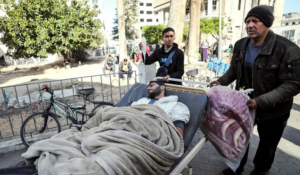North Gaza’s last hospital has no power or water, UN reports after rare visit as crisis worsens

A wounded Palestinian is evacuated from Kamal Adwan Hospital on 28 December 2024
Nir Hasson reports in Haaretz on 31 December, 2024:
The humanitarian situation in the Gaza Strip is getting worse. In the north, the health system has completely collapsed; in the south, looting of food and aid shipments persists, and across Gaa hundreds of thousands of displaced persons must endure the cold weather and flooding of their tents.
Over the weekend, for the first time in weeks, the Israel Defense Forces permitted a UN delegation to enter the Indonesian Hospital in northern Gaza, an area that has been under attack for almost three months. The Indonesian Hospital is the only active hospital in the area after the IDF shut down the Kamal Adwan Hospital over the weekend, citing security concerns. Patients and displaced persons were moved to the Indonesian Hospital after Kamal Adwan’s forced closure.
Members of the delegation, including staff from the United Nations Office for the Coordination of Humanitarian Affairs (OCHA) and the World Health Organization, reported that the situation in the Indonesian Hospital is dire and that it lacks the basic conditions for treating patients – including electricity, running water and a sanitation system.
Jonathan Whittall, interim head of OCHA in the West Bank, said in a video posted by the UN that in the past two months, the UN has submitted 140 requests to the IDF to visit the area, and all were denied. “People here have no food, no water, sanitation, nothing … There are still people in Jabalya in the north. They need access. They need us to be able to reach them … We need to be able to provide the basics for survival,” he added.
The UN estimates that between 10,000 and 15,000 people remain in the besieged northern Gaza, though the exact number is unknown.
A member of the delegation who spoke with displaced Gazans at the Indonesian Hospital said that many locals refuse to leave the north. “They have families here, they have friends, they say they need to stay.”
The UN delegation collected 10 patients in serious condition who’d been transferred on Saturday from Kamal Adwan Hospital to the Indonesian Hospital. The delegation sought to transfer them to Al-Shifa Hospital in Gaza City, but the army stopped the convoy on the way and arrested four of the 10 patients.
WHO chief Tedros Adhanom Ghebreyesus said in a post on X on Monday that “Hospitals in Gaza have once again become battlegrounds and the health system is under severe threat … We repeat: stop attacks on hospitals. People in Gaza need access to health care. Humanitarians need access to provide health aid. Cease-fire!”
He also highlighted the detention of the Kamal Adwan Hospital director Dr. Husam Abu Safia by the IDF on Sunday. “His whereabouts are unknown. We call for his immediate release. On Sunday, released prisoners from the Sde Teiman detention facility in southern Israel said that Dr. Abu Safia was being held there, where his son says he is subject to abuse and humiliation. MK Ahmad Tibi contacted Israel’s defense minister to ask for permission to visit Dr. Abu Safia in detention.
“A brave doctor whose 15-year-old son was killed, and who was then wounded when his hospital came under fire. He stayed there, with his team, with the patients – This is a brave decision. And then he went out to the tank and was arrested,” Tibi said. “Now he is in Sde Teiman and there is an international call to release him. Why? Because at Sde Teiman, doctors are killed. Dr. Adnan Al-Bursh, an orthopedist, was arrested, and tortured and died. Today, I call upon the defense minister to release him.”
Humanitarian activists say the situation is also worsening in southern Gaza, where the majority of Gaza’s population now lives. On Friday and Saturday, not a single aid truck entered the area.
During a food distribution for displaced persons on Friday, a food truck was looted, and 250 food packages were stolen and never reached their destination. The next day, two UNRWA fuel tanks were also looted. Two days ago, five trucks entered through the Kerem Shalom crossing and another 65 trucks from the crossing in central Gaza, but half of them were also looted on the way and didn’t reach the distribution points.
According to international sources, the social collapse, along with increasing looting and theft, is intensifying. “The gangs are becoming stronger and more violent. We can’t reach the residents due to insecurity,” said a humanitarian activist in the southern Gaza Strip.
The Hamas-run Information Ministry released a statement attacking the World Food Programme, claiming that the convoy sent two days ago was poorly coordinated, and that the security personnel in the convoy were responsible for the deaths of two civilians. According to the WFP, a “coordinated movement to bring in 40 trucks on behalf of humanitarian partners” on Sunday was “faced with violent, armed looting, resulting in the deaths of two”.
The weather is also significantly affecting displaced persons in southern Gaza. Most of the 1.7 million displaces persons who now reside in the area live in tents and temporary shelters, which often flood in heavy rains.
The winter storms also bring cold temperatures. “It’s very cold, there’s no way to warm yourself up. People have burned furniture in order to cook. A lot of tents were damaged, there are holes, including in some tents that have been up for a year already,” a humanitarian activist says.
“Also, the sewage system isn’t working. People are living in tents that get flooded by sewage. There isn’t enough food. People are sick, but the hospitals don’t have what they need for disinfecting and contagious diseases spread to patients there. There’s a circle of people who are becoming weaker, hungrier and sicker.”
This article is reproduced in its entirety
